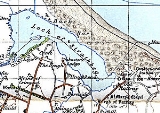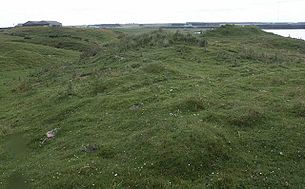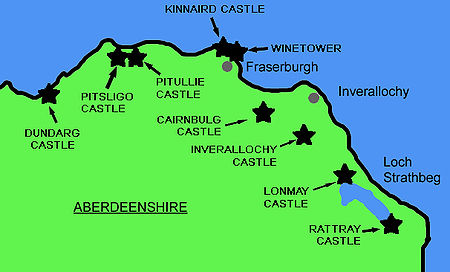
Castle of Rattray
Encyclopedia


- note: this is a different Castle of Rattray to that of Clan RattrayClan RattrayClan Rattray is a Highland Scottish clan.-Origins of the clan:The name Rattray is derived from the barony of Rattray in Perthshire, Scotland. Legend has it that their land there was acquired from King Malcolm III of Scotland in the 11th century. Unfortunately there is no extant written record of...
's Craighall Castle in Perthshire.
The Castle of Rattray was a medieval Scottish
Scotland
Scotland is a country that is part of the United Kingdom. Occupying the northern third of the island of Great Britain, it shares a border with England to the south and is bounded by the North Sea to the east, the Atlantic Ocean to the north and west, and the North Channel and Irish Sea to the...
castle, with multiple variations on its structure over approximately six centuries. Originally built as a "late 12th- or early 13th century defensive motte
Motte-and-bailey
A motte-and-bailey is a form of castle, with a wooden or stone keep situated on a raised earthwork called a motte, accompanied by an enclosed courtyard, or bailey, surrounded by a protective ditch and palisade...
" it provided protection for Starny Keppie harbour and Rattray village. Sometime between 1214 and 1233 it was upgraded by William Comyn, jure uxoris Earl of Buchan
William Comyn, jure uxoris Earl of Buchan
William Comyn was one of four sons of Richard Comyn, Justiciar of Lothian and Hextilda of Tynedale. He was born in Scotland, in Altyre, Moray in 1163 and died in Buchan in 1233 where he is buried in Deer Abbey...
before being destroyed in the 1308 Harrying of Buchan
Harrying of Buchan
The Harrying of Buchan, also known as the Herschip or Rape of Buchan, took place in 1308 during the Wars of Scottish Independence...
. After Comyn's timber castle was burned down it was replaced by a stronger stone castle which was engulfed during a 1720 sand storm along with nearby Rattray
Rattray, Aberdeenshire
Rattray , had been settled as far back as 4000 BC and was named a Royal Burgh in 1563 by Mary, Queen of Scots, "to put an end to the disputes about superiority over it between William Keith, 4th Earl Marischal and George Hay, 7th Earl of Erroll"...
village. After the storm, the castle was not dug out and remains covered to this day.
Location
The castle was sited on Castlehill, on the south bank of the now closed estuary flowing into Strathbeg BayLoch Strathbeg
The Loch of Strathbeg is a designated Special Protection Area for wildlife conservation purposes...
- the north bank was protected by the opposite Lonmay Castle
Lonmay Castle
The remains of the Castle of Lonmay are found near Netherton of Lonmay, to the north of Loch Strathbeg in Buchan, Scotland. The remains are not located in the modern village of Lonmay which is approximately 6km to the south west....
. Specifically the castle was "beside an inlet which led from the sea into a sheltered harbour" on "the harbour side" of Rattray village. The later stone castle is known to have had a "harbour-side entrance".
Originally situated on "a rock near the sea", Castlehill is today about 1 mile inland as shifting sands have significantly altered the shape of the coast. Located to the south of Loch Strathbeg
Loch Strathbeg
The Loch of Strathbeg is a designated Special Protection Area for wildlife conservation purposes...
it can been seen as a grassy "circular mound" which is "oval & natural with its top slightly dished". A 1791 book states it has a "summit"... [of] "half a Scots acre" (approx. 0.25 hectare
Hectare
The hectare is a metric unit of area defined as 10,000 square metres , and primarily used in the measurement of land. In 1795, when the metric system was introduced, the are was defined as being 100 square metres and the hectare was thus 100 ares or 1/100 km2...
) and "rises 38 feet"... (11.6 metres) "above a small plain on the"... north-east "but is only 12 or 14 feet"... (3.7 or 4.3 metres) "above the higher ground" to the south-west.
c.1100 AD to c.1200 AD
The first construction on Castlehill was a small late middle ageScotland in the Late Middle Ages
Scotland in the late Middle Ages established its independence from England under figures including William Wallace in the late 13th century and Robert Bruce in the 14th century...
, 12th century "timber castle or Motte
Motte-and-bailey
A motte-and-bailey is a form of castle, with a wooden or stone keep situated on a raised earthwork called a motte, accompanied by an enclosed courtyard, or bailey, surrounded by a protective ditch and palisade...
" built to protect the estuary.
Comyn period (c.1200 AD - 1308 AD)
In the 13th century the Castle of Rattray was "the principal seat of the Cummings"... [alt. spelling of Comyn] "Earls of Buchan" who arrived at the start of that century. Between 1214 when he inherited the Earldom of BuchanEarl of Buchan
The Mormaer or Earl of Buchan was originally the provincial ruler of the medieval province of Buchan. Buchan was the first Mormaerdom in the High Medieval Kingdom of the Scots to pass into the hands of a non-Scottish family in the male line. The earldom had three lines in its history, not counting...
and his own death in 1233, William Comyn, jure uxoris Earl of Buchan
William Comyn, jure uxoris Earl of Buchan
William Comyn was one of four sons of Richard Comyn, Justiciar of Lothian and Hextilda of Tynedale. He was born in Scotland, in Altyre, Moray in 1163 and died in Buchan in 1233 where he is buried in Deer Abbey...
built upon the motte but it is unclear whether he upgraded the existing buildings or built an entirely new castle. He is known to have completed a "manor house" with "a fine timber-framed hall" (the castle) which was accompanied by the private St Mary's
St Mary's Chapel, Rattray
St Mary's Chapel is a late 12th/early 13th century chapel found in Rattray, Aberdeenshire, Scotland. It was built by William Comyn, jure uxoris Earl of Buchan during the same period as the Castle of Rattray and was "private chapel for the castle" and its residents...
Chapel which he constructed "a quarter of a mile" (0.4 kilometres) south, in Rattray village itself.
In the mid-1270s it is reported that "a castle-strengthening programme at"... "Rattray" took place.
Comyn's castle survived until the Harrying of Buchan
Harrying of Buchan
The Harrying of Buchan, also known as the Herschip or Rape of Buchan, took place in 1308 during the Wars of Scottish Independence...
in the summer of 1308, when all the Comyn lands were bloodily burnt to the ground after John Comyn, Earl of Buchan
John Comyn, Earl of Buchan
John Comyn was Earl of Buchan and an important member of Clan Comyn during the early 14th century. He was a chief opponent of Robert the Bruce in the civil war that paralleled the War of Scottish Independence. He should not be confused with the better known John III Comyn, Lord of Badenoch, who...
was beaten at the Battle of Barra. The timber Rattray Castle was almost certainly attacked by Robert the Bruce or his younger brother Edward
Edward Bruce
Edward the Bruce , sometimes modernised Edward of Bruce, was a younger brother of King Robert I of Scotland, who supported his brother in the struggle for the crown of Scotland, then pursued his own claim in Ireland. He was proclaimed High King of Ireland, but was eventually defeated and killed in...
after which the "castle fell into ruins" if not burned to the ground.
1308 AD - 1720 AD
Following the Harrying, the site of Rattray's timber castle was rebuilt with a "stone built hall". This stone incarnation provided protection for Starnie Keppie harbour and the village at Rattray, as the previous incarnations did.The Earldom of Buchan and hence the castle was inherited and divided after the harrying between John Comyn's two nieces. Henry de Beaumont
Henry de Beaumont
Henry de Beaumont, jure uxoris 4th Earl of Buchan and suo jure 1st Baron Beaumont was a key figure in the Anglo-Scots wars of the thirteenth and fourteenth centuries, known as the Wars of Scottish Independence.-Life:...
, the husband of one niece; Alice Comyn, claimed the title under her name but was disinherited from the lands in 1314. A 1324 charter from Robert the Bruce then gives the "lordship of Rattray" to Sir Archibald Douglas
Sir Archibald Douglas
Sir Archibald Douglas was a Scottish noble, Guardian of Scotland and military leader. He is sometimes given the epithet "Tyneman" , but this may be a reference to his great-nephew Archibald Douglas, 4th Earl of Douglas.-Early life:The younger son of Sir William "le Hardi" Douglas, the Governor of...
. The lands again change hands in 1382 when Alexander Stewart was given the Earldom by his father Robert II of Scotland
Robert II of Scotland
Robert II became King of Scots in 1371 as the first monarch of the House of Stewart. He was the son of Walter Stewart, hereditary High Steward of Scotland and of Marjorie Bruce, daughter of Robert I and of his first wife Isabella of Mar...
.
Mary, Queen of Scots, declared Rattray a Royal Burgh
Royal burgh
A royal burgh was a type of Scottish burgh which had been founded by, or subsequently granted, a royal charter. Although abolished in 1975, the term is still used in many of the former burghs....
in 1563 "to put an end to the disputes about superiority over it between William Keith, 4th Earl Marischal
Earl Marischal
The title of Earl Marischal was created in the peerage of Scotland for William Keith, the Great Marischal of Scotland.The office of "Marischal of Scotland" had been held heritably by the senior member of the Keith family since Hervey de Keith, who held the office of Marischal under Malcolm IV and...
and George Hay, 7th Earl of Erroll
Earl of Erroll
The Earl of Erroll is an ancient title in the Peerage of Scotland. It was created in 1453 for Sir William Hay.The subsidiary titles held by the Earl of Erroll are Lord Hay and Lord Slains , both in the Peerage of Scotland. The Earls of Erroll also hold the hereditary office of Lord High Constable...
". The importance of the Burgh is questionable due to the fact "it does not appear to have long enjoyed that privilege not being ranked in the roll of boroughs for many ages" and as it was "said to have had all tire privileges of a royal borough except sending members to parliament"
In later years Rattray was run by a feudal system of superiors who maintained the land for the Crown
The Crown
The Crown is a corporation sole that in the Commonwealth realms and any provincial or state sub-divisions thereof represents the legal embodiment of governance, whether executive, legislative, or judicial...
, some of whom are known due to charters that they granted. "David Rivis"... "superior of the lands of Rattray" granted a charter in 1617; "William Watson of Haddo, bailie of the burgh of Rattray, superior" [of Rattray] granted a charter in 1675 and "Charles".. [Hay, 13th] "Earl of Erroll
Earl of Erroll
The Earl of Erroll is an ancient title in the Peerage of Scotland. It was created in 1453 for Sir William Hay.The subsidiary titles held by the Earl of Erroll are Lord Hay and Lord Slains , both in the Peerage of Scotland. The Earls of Erroll also hold the hereditary office of Lord High Constable...
, superior of the lands of Rattray" granted a charter in 1711.
The destruction of the stone castle and the nearby village of Rattray, is said by "a tradition" to have happened during the great storm of 1720 which cut off Strathbeg Bay. It is believed that the castle was "blown over with sand one Sunday evening while the" inhabitants, "a godless crew".. "were engaged in playing cards". "on the Sabbath, [when] they were buried alive."
Another story tells that the site was "buried because of the plague." however there is no date or record of which plague and it is a very unlikely account.
1720AD(approx) - 1988
Today there is not much to be seen at the site as the remains have "for a long period [been] covered with a deep soil, and now- the swords of the warlike house beaten literally into ploughshares". In c.1730, a dig on the south-east "side of the Castle-hill"... "found a great number of stones, supposed to belong to the kitchen of the castle, as"... "workmen found very large hearth-stones covered with ashes."Items recovered include; "a quantity of regularly-laid stones were removed c.1734 and some silver coins" as well as two kiln stands found in 1829 (today held in Marischal Museum
Marischal Museum
The Marischal Museum is the main museum in the city centre of Aberdeen, Scotland. It was established in 1786 and is situated in the architecturally notable Marischal College building, part of the University of Aberdeen....
, Aberdeen).
In 1740 "a man who drove his spade through the panel of a door was immediately suffocated" having got caught in the sand and at an unknown date, a "well-made causeway was discovered at the foot of the mound under which the Castle is said to be buried."
1985-1989 Excavations
Thorough excavations at Castlehill in 1985-1989 revealed the remains of the stone castle and traces of the previous timber one. Traces of the stone castle, revealed a "perimeter wall".. and "two mural buildings". It also ascertained that the later stone castle was approximately "20m by 6.5 m" and "divided into three parts, a central room, and two smaller end rooms". It likely supported more than one storey, due to the "indication of a possible forestair"... and "the wall thickness."The results of this excavation can be found in the Journal article (available free from the link in journal citation below) "Excavations at Rattray, Aberdeenshire. A Scottish deserted burgh" by "Murray & Murray" and forms the most complete modern and peer-reviewed academic account of the Castle of Rattray available to historians and archaeologists today.
1989 - present
Aberdeen City Council roday holds various artifacts from Rattray and the Castlehill site and has previously held a temporary display of artifacts at James Dun's HouseJames Dun's House
James Dun's House is located in Aberdeen, Scotland. It is a beautiful building on Schoolhill that was a popular museum and gallery with changing exhibitions but in 2001 was converted into a hairdresser and cafe....
in Aberdeen.
External links
- Artists impressions of the site from the Scran databaseScranScran is a Scottish online resource for educational use by the public, schools, further education and higher education. It presents 360,000 images and sounds contributed by museums, galleries, archives and the media...
of: 12th to 13th-centuries; 13th century; 14th century.

